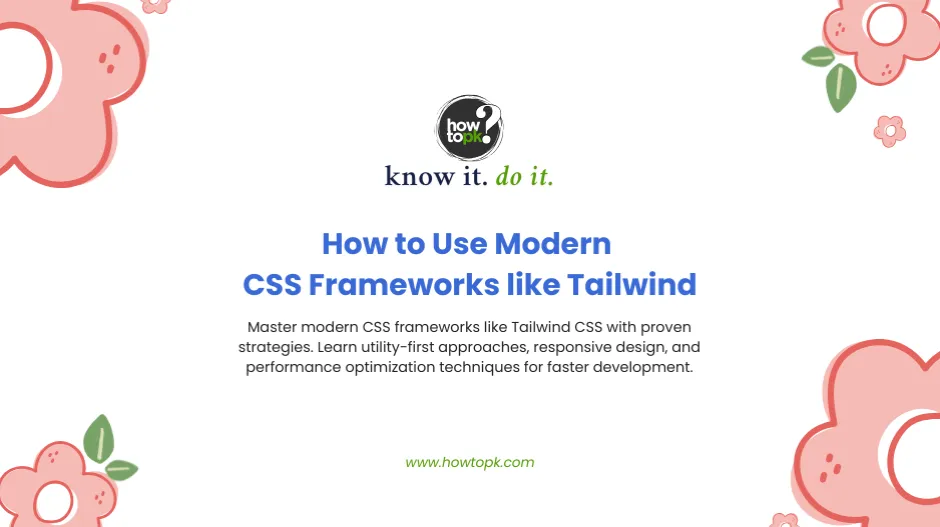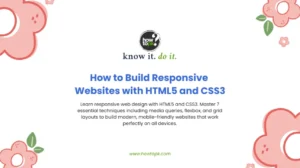Modern web development has evolved dramatically, and Tailwind CSS stands at the forefront of this transformation. As developers seek more efficient ways to build responsive, maintainable websites, understanding how to leverage modern CSS frameworks has become essential for creating professional web applications.
Whether you’re transitioning from traditional CSS or exploring alternatives to Bootstrap, mastering utility-first frameworks can revolutionize your development process. This comprehensive guide will walk you through proven strategies, best practices, and real-world applications that will elevate your front-end development skills.
Understanding Modern CSS Framework Philosophy
The Shift from Component-Based to Utility-First
Traditional CSS frameworks like Bootstrap provide pre-built components, but modern frameworks embrace a fundamentally different approach. Instead of predefined components, you compose designs using small, single-purpose utility classes.
Consider this comparison:
Traditional Approach:
.card {
background: white;
border-radius: 8px;
padding: 24px;
box-shadow: 0 2px 4px rgba(0,0,0,0.1);
}
Tailwind CSS Approach:
<div class="bg-white rounded-lg p-6 shadow-md">
<!-- Card content -->
</div>
This utility-first methodology offers unprecedented flexibility while maintaining consistency across your design system.
Getting Started with Tailwind CSS
Installation and Setup Options
Tailwind provides multiple installation methods to accommodate different project requirements:
| Method | Best For | Setup Time |
|---|---|---|
| CDN | Quick prototyping | 2 minutes |
| npm/yarn | Production projects | 10 minutes |
| CLI Tool | Simple builds | 5 minutes |
| PostCSS | Custom workflows | 15 minutes |
For production applications, install via npm:
npm install -D tailwindcss
npx tailwindcss init
Configure your tailwind.config.js to specify content sources:
module.exports = {
content: ["./src/**/*.{html,js}"],
theme: {
extend: {},
},
plugins: [],
}
Essential Configuration Strategies
Proper configuration ensures Tailwind CSS integrates seamlessly with your development workflow. Focus on these critical areas:
- Content Configuration: Specify all template files to ensure proper purging of unused styles. This dramatically reduces final CSS bundle size.
- Theme Customization: Extend default values rather than overriding them completely. This preserves framework benefits while accommodating brand requirements.
- Plugin Integration: Leverage official plugins for forms, typography, and aspect ratios to enhance functionality without custom CSS.
Core Utility Classes and Design Patterns
Mastering Layout with Flexbox and Grid
Tailwind CSS excels at creating complex layouts through intuitive utility classes. Understanding these patterns accelerates development significantly:
Flexbox Patterns:
flex justify-between items-centercreates navigation barsflex flex-col space-y-4builds vertical component stacksflex flex-wrap gap-4manages responsive card grids
Grid Patterns:
grid grid-cols-1 md:grid-cols-3 gap-6creates responsive layoutsgrid grid-rows-[auto_1fr_auto]builds full-height page structuresgrid place-items-centercenters content perfectly
Responsive Design Implementation
Modern CSS frameworks excel at responsive design, and Tailwind CSS provides an intuitive mobile-first approach. The framework uses predictable breakpoint prefixes:
<div class="text-sm md:text-base lg:text-lg xl:text-xl">
Responsive typography scaling
</div>
This approach ensures consistent behavior across devices while maintaining clean, readable markup.
Color System and Design Consistency
Tailwind CSS includes a comprehensive color palette that promotes visual consistency. The framework provides semantic color classes that work harmoniously:
- Gray scales: Perfect for text hierarchy and subtle backgrounds
- Brand colors: Blue, green, red variations for different contexts
- Opacity utilities: Transparent overlays and subtle effects
Combine colors with opacity modifiers for sophisticated effects: bg-blue-500/20 creates a 20% opacity blue background.
Advanced Tailwind CSS Techniques
Custom Utility Creation
While Tailwind CSS includes extensive utilities, projects sometimes require custom additions. The @layer directive allows seamless integration:
@tailwind base;
@tailwind components;
@tailwind utilities;
@layer utilities {
.text-shadow {
text-shadow: 2px 2px 4px rgba(0,0,0,0.3);
}
}
Component Composition Strategies
Although Tailwind CSS emphasizes utilities over components, complex applications benefit from reusable component patterns. Consider these approaches:
Template-Based Components: Create reusable HTML templates with consistent utility combinations.
CSS Components: Use @apply directive for frequently repeated utility combinations:
@layer components {
.btn-primary {
@apply bg-blue-500 hover:bg-blue-600 text-white font-medium py-2 px-4 rounded-lg transition-colors;
}
}
JavaScript Framework Integration: Combine utilities with component-based frameworks like React, Vue, or Angular for maximum reusability.
Performance Optimization Techniques
Bundle Size Management
Tailwind CSS generates large CSS files during development but provides excellent production optimization tools. The framework automatically removes unused styles through purging:
Configure purging to scan all template files:
module.exports = {
content: [
"./pages/**/*.{js,ts,jsx,tsx}",
"./components/**/*.{js,ts,jsx,tsx}",
],
// ... rest of config
}
JIT (Just-In-Time) Compilation
Modern Tailwind CSS versions include JIT compilation, generating styles on-demand rather than pre-building everything. This approach provides:
- Instant build times during development
- Smaller development CSS files
- Support for arbitrary value utilities
- Dynamic class generation capabilities
Enable JIT mode for optimal performance across all project phases.
Integration with Popular Development Stacks
React and Next.js Integration
Tailwind CSS pairs exceptionally well with React-based applications. Installation with Next.js requires minimal configuration:
npm install -D tailwindcss postcss autoprefixer
npx tailwindcss init -p
Create reusable React components using utility classes:
function Button({ variant = 'primary', children, ...props }) {
const baseClasses = 'font-medium py-2 px-4 rounded-lg transition-colors';
const variantClasses = {
primary: 'bg-blue-500 hover:bg-blue-600 text-white',
secondary: 'bg-gray-200 hover:bg-gray-300 text-gray-900',
};
return (
<button
className={`${baseClasses} ${variantClasses[variant]}`}
{...props}
>
{children}
</button>
);
}
Vue.js and Nuxt.js Compatibility
Vue applications integrate seamlessly with Tailwind CSS through similar configuration processes. The framework’s utility-first approach complements Vue’s component architecture perfectly.
Backend Framework Integration
Tailwind CSS works excellently with server-side frameworks like Laravel, Django, and Ruby on Rails. The framework processes templates regardless of backend technology, ensuring consistent styling across full-stack applications.
Best Practices and Common Pitfalls
Maintaining Code Readability
While Tailwind CSS utilities provide flexibility, excessive class lists can reduce readability. Follow these guidelines:
- Group Related Utilities: Organize classes logically (layout, spacing, colors, typography).
- Use Consistent Patterns: Establish team conventions for common utility combinations.
- Leverage Editor Extensions: Install Tailwind CSS IntelliSense for improved development experience.
Avoiding Over-Customization
- Tailwind CSS design system promotes consistency, but excessive customization can undermine these benefits:
- Extend Rather Than Replace: Add custom values while preserving default scales.
- Document Custom Utilities: Maintain clear documentation for team-specific additions.
- Regular Audits: Periodically review custom utilities to prevent bloat.
Comparing Modern CSS Frameworks
Tailwind CSS vs. Bootstrap
Feature | Tailwind CSS | Bootstrap |
Approach | Utility-first | Component-based |
Customization | Highly flexible | Theme-based |
Bundle Size | Optimized (purged) | Larger baseline |
Learning Curve | Moderate | Gentle |
Design Freedom | Maximum | Constrained |
Alternative Modern Frameworks
- Bulma: CSS-only framework with modern flexbox-based components.
- Tachyons: Functional CSS approach similar to Tailwind CSS philosophy.
- Chakra UI: Component library with utility-based styling system.
- Styled System: CSS-in-JS utilities for React applications.
Each framework serves different project requirements and team preferences.
Future-Proofing Your CSS Framework Skills
Emerging Trends and Technologies
Modern CSS frameworks continue evolving rapidly. Stay current with these developments:
- CSS Grid Adoption: Advanced grid utilities for complex layouts.
- Container Queries: Responsive design based on container size rather than viewport.
- CSS Custom Properties: Dynamic theming and runtime customization.
- Performance Optimization: Advanced techniques for minimal bundle sizes.
Continuous Learning Resources
- Official Tailwind CSS Documentation – Comprehensive reference and guides
- Tailwind UI – Professional component examples and patterns
- Headless UI – Unstyled, accessible UI components for Tailwind CSS
- Tailwind Labs YouTube Channel – Official tutorials and updates
Conclusion
Mastering Tailwind and modern CSS frameworks represents a significant investment in your development capabilities. The utility-first approach initially requires adjustment from traditional CSS methodologies, but the long-term benefits include faster development, improved consistency, and better maintainability.
Success with Tailwind comes from understanding its philosophy, practicing with real projects, and gradually building expertise with advanced techniques. Start with simple components, experiment with utility combinations, and progressively tackle more complex design challenges.
The modern web development landscape continues evolving, but frameworks like Tailwind provide solid foundations for building responsive, performant, and maintainable user interfaces. Embrace the utility-first mindset, leverage the framework’s strengths, and transform your development workflow for lasting success.











